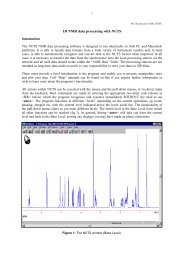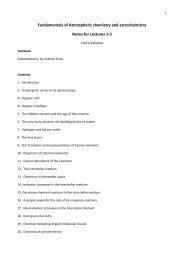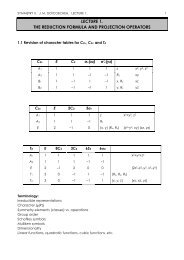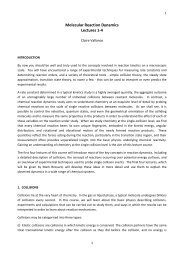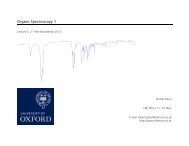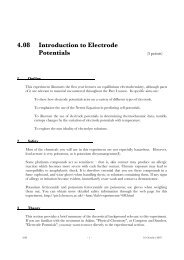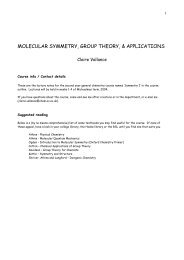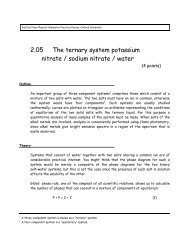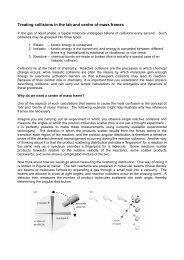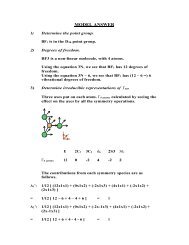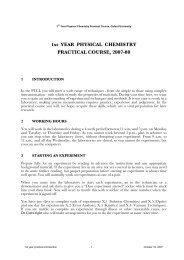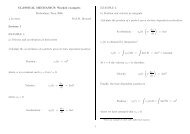Einstein and Debye heat capacities of solids
Einstein and Debye heat capacities of solids
Einstein and Debye heat capacities of solids
You also want an ePaper? Increase the reach of your titles
YUMPU automatically turns print PDFs into web optimized ePapers that Google loves.
Heat <strong>capacities</strong> <strong>of</strong> <strong>solids</strong><br />
Any theory used to calculate lattice vibration <strong>heat</strong> <strong>capacities</strong> <strong>of</strong> crystalline <strong>solids</strong> must explain two<br />
things:<br />
1. Near room temperature, the <strong>heat</strong> capacity <strong>of</strong> most <strong>solids</strong> is around 3k per atom (the molar<br />
<strong>heat</strong> capacity for a solid consisting <strong>of</strong> n-atom molecules is ~3nR). This is the well-known<br />
Dulong <strong>and</strong> Petit law.<br />
2. At low temperatures, C v decreases, becoming zero at T=0. Heat <strong>capacities</strong> have a<br />
temperature dependence <strong>of</strong> the form αT 3 + γT, where the T 3 term arises from lattice<br />
vibrations, <strong>and</strong> the linear term from conduction electrons.<br />
Classical mechanics would predict C v = 3R at all temperatures, in violation <strong>of</strong> both experiment <strong>and</strong> the<br />
third law <strong>of</strong> thermodynamics.<br />
<strong>Einstein</strong>’s theory <strong>of</strong> <strong>heat</strong> <strong>capacities</strong><br />
<strong>Einstein</strong> treated the atoms in a crystal as N simple harmonic oscillators, all having the same frequency<br />
ν E . The frequency ν E depends on the strength <strong>of</strong> the restoring force acting on the atom, i.e. the<br />
strength <strong>of</strong> the chemical bonds within the solid. Since the equation <strong>of</strong> motion for each atom<br />
decomposes into three independent equations for the x, y <strong>and</strong> z components <strong>of</strong> displacement, <strong>and</strong> N-<br />
atom solid is equivalent to 3N harmonic oscillators, each vibrating independently at frequency ν E .<br />
Note that this treatment is a gross approximation, since in reality the lattice vibrations are very<br />
complicated coupled oscillations.<br />
The energy levels <strong>of</strong> the harmonic oscillators are given by<br />
ε v = hν E (v + ½), v = 0, 1, 2…<br />
Assuming the oscillators are in thermal equilibrium at temperature T, the partition function for a<br />
single oscillator is<br />
∞<br />
∞<br />
q = ∑exp[-βε v ] = ∑exp[-βhν E (v+½)] = e -x/2 ∑<br />
∞e -xv = e-x/2<br />
1-e -x where x = βhν E .<br />
v=0<br />
v=0<br />
v=0<br />
∞<br />
In the above, we have used the fact that ∑n=0 x n =<br />
The mean energy per oscillator is then<br />
1<br />
1 - x .<br />
u = - dlnq<br />
dβ = d<br />
dβ⎝ ⎛ βhν E<br />
⎠ ⎞<br />
2 + ln(1-e-βhν E) =<br />
hν E<br />
2 + hν<br />
e βh ν E-1<br />
The first term above, hν/2, is simply the zero point energy. Using the fact that energy is an extensive<br />
property, the energy <strong>of</strong> the 3N oscillators in the N-atom solid is<br />
U = 3Nu = 3N ⎝<br />
⎜ ⎛<br />
hν E<br />
2 + hν<br />
e βh ν E-1<br />
⎠ ⎟⎞
The <strong>heat</strong> capacity at constant volume is therefore<br />
∂U⎞<br />
⎛<br />
C v = ⎝ ∂T⎠<br />
= 3N v ⎝ ⎛ ∂U<br />
⎠ ⎞<br />
∂β<br />
∂β v ∂T = 3Nk x2 e x<br />
(e x -1) 2 where x = hν E<br />
kT = θ E<br />
T<br />
θ E is the ‘<strong>Einstein</strong> temperature’, which is different for each solid, <strong>and</strong> reflects the rigidity <strong>of</strong> the<br />
lattice.<br />
At the high temperature limit, when T >> θ E (<strong>and</strong> x 1), C v 0 as T 0, as required by the third law <strong>of</strong><br />
thermodynamics. [Prove by setting e x -1 ~ e x in the denominator for large x].<br />
<strong>Debye</strong>’s theory <strong>of</strong> <strong>heat</strong> <strong>capacities</strong><br />
<strong>Debye</strong> improved on <strong>Einstein</strong>’s theory by treating the coupled vibrations <strong>of</strong> the solid in terms <strong>of</strong> 3N<br />
normal modes <strong>of</strong> vibration <strong>of</strong> the whole system, each with its own frequency. The lattice vibrations<br />
are therefore equivalent to 3N independent harmonic oscillators with these normal mode frequencies.<br />
For low frequency vibrations, defined as those for which the wavelength is much greater than the<br />
atomic spacing, λ >> a, the crystal may be treated as a homogeneous elastic medium. The normal modes<br />
are the frequencies <strong>of</strong> the st<strong>and</strong>ing waves that are possible in the medium.<br />
<strong>Debye</strong> derived an expression for the number <strong>of</strong> modes with frequency between ν <strong>and</strong> ν+dν in such a<br />
medium.<br />
g(ν) dν = 4πVν2<br />
v 3 dν = α ν 2 dν<br />
where V is the crystal volume <strong>and</strong> v is the propagation velocity <strong>of</strong> the wave. As outlined above, this<br />
expression applies only to low frequency vibrations in a crystal. <strong>Debye</strong> used the approximation that it<br />
applied to all frequencies, <strong>and</strong> introduced a maximum frequency ν D (the <strong>Debye</strong> frequency) such that<br />
there were 3N modes in total. i.e. ⌡ ⌠ νD<br />
g(ν)dν = 3N . The <strong>Debye</strong> frequency corresponds to λ = 2a, when<br />
0<br />
neighbouring atoms vibrate in antiphase with each other. With this approximation in place, <strong>Debye</strong><br />
integrated over all <strong>of</strong> the frequencies to find the internal energy <strong>of</strong> the crystal, <strong>and</strong> then calculated<br />
⎛∂U⎞<br />
the <strong>heat</strong> capacity using C v = ⎝<br />
. The resulting expression is given below.<br />
∂T⎠<br />
v<br />
C v = 3Nk ⎜ ⎛ 3<br />
3<br />
⎝<br />
x<br />
⎠ ⎟⎞<br />
D<br />
⎮ ⌠ xD<br />
x 4 e x dx<br />
⌡ (e x - 1) 2<br />
0<br />
where x = hν<br />
kT , <strong>and</strong> x D = hν D<br />
kT = θ D<br />
T . The <strong>Debye</strong> <strong>heat</strong> capacity depends only on the <strong>Debye</strong> temperature θ D.<br />
The integral cannot be evaluated analytically, but the bracketed function is tabulated.<br />
At high temperatures (T >> θ D , x D
x 4 e x<br />
(e x - 1) 2 = x 4<br />
(e x - 1)(1 - e x ) = x 4<br />
2(cosh(x) - 1) = x 4<br />
2(x 2 /2! + x 4 /4! + …)<br />
Retaining only the x 2 term in the denominator gives<br />
C v = 3Nk ⎜ ⎛ 3 xD<br />
3 ⌠<br />
⎝<br />
x<br />
⎠ ⎟⎞<br />
D ⌡ x 2 dx = 3Nk<br />
0<br />
To determine the low temperature limit (T > 1), we note that the integr<strong>and</strong> tends towards<br />
zero rapidly for large x. This allows us to replace the upper limit by ∞ <strong>and</strong> turn the integral into a<br />
st<strong>and</strong>ard integral, to give<br />
3<br />
⎛ T⎞<br />
C v = 3Nk ⎝ θ D⎠ ⎛<br />
⎜3 ⌠<br />
⎝ ⌡<br />
0<br />
∞<br />
x 4 e x<br />
⎞<br />
(e x - 1) 2 ⎟<br />
⎠<br />
= 12 ⎛ T⎞<br />
5 π4 Nk ⎝ ⎠<br />
We see that the <strong>Debye</strong> <strong>heat</strong> capacity decreases as T 3 at low temperatures, in agreement with<br />
experimental observation. This is a marked improvement on <strong>Einstein</strong>’s theory.<br />
θ D<br />
3<br />
Free electron model <strong>of</strong> metals<br />
Up to this point, we have only considered contributions to the <strong>heat</strong> capacity from vibrations within the<br />
solid. In metals, the free conduction electrons also contribute to the <strong>heat</strong> capacity. In the free<br />
electron model <strong>of</strong> metals, the conduction electrons are treated as a perfect gas obeying Fermi-Dirac<br />
statistics. Interactions <strong>of</strong> the electrons with the positively charged atomic ions <strong>and</strong> with the other<br />
electrons are neglected. This is not such a bad approximation as it may appear at first: the ions<br />
provide a positively charged background that partly screens the electrons from each other; <strong>and</strong> the<br />
residual collisions are <strong>of</strong>ten relatively unimportant - the energetically accessible final states are <strong>of</strong>ten<br />
already occupied, making any collisional excitation process forbidden by the Pauli exclusion principle.<br />
The first step in deriving the <strong>heat</strong> capacity is to determine the density <strong>of</strong> states. We will first do this<br />
in momentum space, <strong>and</strong> then transform the result into an expression describing the density <strong>of</strong> states<br />
per unit energy.<br />
The 3-dimensional Schrodinger equation for the translational motion <strong>of</strong> the electrons has the solutions<br />
with k = ⎝<br />
⎛<br />
πn 1<br />
, πn 2<br />
L L , πn 3<br />
L<br />
⎛n 1 π x⎞ ⎛n 2 π y⎞ ⎛n 3 π z⎞<br />
φ n1 n 2<br />
n 3<br />
(r) = A sin ⎝<br />
sin<br />
L ⎠ ⎝<br />
sin<br />
L ⎠ ⎝ L ⎠<br />
⎞<br />
⎠<br />
<strong>and</strong> k 2 = π2<br />
L 2 (n 1 2 + n 2 2 + n 3 2 ).<br />
The allowed values <strong>of</strong> k therefore form a cubic point lattice in k-space, with spacing π/L <strong>and</strong> volume<br />
per point (π/L) 3 . Finding the number <strong>of</strong> normal modes <strong>of</strong> the st<strong>and</strong>ing wave wavefunctions with k<br />
between k <strong>and</strong> k+dk is equivalent to finding the number <strong>of</strong> lattice points between two spherical shells<br />
<strong>of</strong> radii k <strong>and</strong> k+dk in the positive octant <strong>of</strong> k-space. The number <strong>of</strong> k-vectors <strong>of</strong> magnitude ≤ k is<br />
n k =<br />
Volume <strong>of</strong> region<br />
Volume per point<br />
=<br />
(1/8) (4/3)πk3<br />
(π/L) 3 = Vk3<br />
6π 2 where V = L3 .<br />
The number f(k) within an interval dk is found by differentiating this expression, giving
f(k) dk = dn k<br />
dk dk = Vk2 dk<br />
2π 2<br />
Since k = 2πp/h (<strong>and</strong> therefore dk = (2π/h)dp), the density <strong>of</strong> states in momentum space is<br />
f(p) dp = 8πVp2 dp<br />
h 3<br />
where an extra factor <strong>of</strong> two has been added to account for the two possible spin states <strong>of</strong> the<br />
electrons. This expression may be converted to an energy density <strong>of</strong> states by substituting ε = p 2 /2m<br />
(<strong>and</strong> so dε = (p/m)dp), to give<br />
f(ε) dε = 4πV<br />
h 3 (2m)3/2 ε 1/2 dε<br />
To determine the number <strong>of</strong> electrons with energies between ε <strong>and</strong> ε+dε, we need to multiply the above<br />
expression, which gives the density <strong>of</strong> states at energy ε, with the probability n(ε) <strong>of</strong> finding an<br />
electron in a given state with energy ε. Electrons are Fermions, <strong>and</strong> obey Fermi-Dirac statistics, so<br />
n(ε) is given by the Fermi-Dirac distribution (Note: the Fermi-Dirac distribution is an analogue <strong>of</strong> the<br />
Boltzmann distribution for systems in which spin must be taken into account)<br />
n(ε) =<br />
1<br />
exp[β(ε-µ)] + 1<br />
where µ is the chemical potential <strong>and</strong> β=1/kT<br />
The number <strong>of</strong> electrons with energy between ε <strong>and</strong> ε+dε is then<br />
dN(ε) = n(ε)f(ε)dε =<br />
1 4πV<br />
exp[β(ε-µ)]+1 h 3 (2m)3/2 ε 1/2 dε<br />
Integrating from zero to infinity gives the total number <strong>of</strong> electrons in the gas. The Fermi energy ε F<br />
is the value <strong>of</strong> µ when T=0 i.e. ε F = µ(0), <strong>and</strong> may also be written ε F = kT F , where T F is the Fermi<br />
temperature.<br />
Now we will look at the energy level occupations n(e) <strong>and</strong> the overall energy distribution N(ε) as the<br />
temperature is increased from zero.<br />
At T=0, the Fermi-Dirac distribution becomes<br />
n(ε) =<br />
1<br />
exp[β(ε-ε F )] + 1<br />
<strong>and</strong> since β=∞ at T=0, this is equal to 0 if ε > ε F <strong>and</strong> 1 if ε < ε F . The two distributions n(ε) <strong>and</strong> N(ε) are<br />
shown below.<br />
1<br />
n( ε)<br />
dN( ε)<br />
dt<br />
0<br />
0<br />
ε/ ε F<br />
1<br />
0 1<br />
ε/ ε F
At higher temperatures, the two distributions change slightly from their behaviour at T=0, due to<br />
electrons lying below the Fermi level being excited to states lying above the Fermi level. This is shown<br />
below.<br />
1<br />
n( ε)<br />
dN( ε)<br />
dt<br />
0<br />
0<br />
ε/ ε F<br />
1<br />
0 1<br />
ε/ ε F<br />
Now we will consider the consequences <strong>of</strong> these distributions for the <strong>heat</strong> capacity. Classical<br />
mechanics would predict a contribution ½ kT per electron to the <strong>heat</strong> capacity, in addition to the <strong>heat</strong><br />
capacity arising from the lattice vibrations. This is a much larger contribution than is observed<br />
experimentally. The answer lies in the Fermionic nature <strong>of</strong> the electrons. In the classical model, a<br />
change in temperature ∆T would lead to an energy increase <strong>of</strong> around k∆T per electron. However, we<br />
have seen that apart from electrons with energies very close to the Fermi energy ε F , the states to<br />
which the electrons would be promoted by an energy increase <strong>of</strong> this magnitude are already occupied.<br />
Hence, only a very small fraction <strong>of</strong> electrons, those lying within ~k∆T <strong>of</strong> the Fermi level, are able to<br />
absorb the energy <strong>and</strong> contribute to the <strong>heat</strong> capacity.<br />
The <strong>heat</strong> capacity per electron turns out to be<br />
C V = π2<br />
2 k T T F<br />
At room temperature this is a very small contribution to the overall <strong>heat</strong> capacity (on the order <strong>of</strong> a<br />
few percent). However, at very low temperatures the electronic <strong>heat</strong> capacity dominates, since it is<br />
linear in temperature while the lattice <strong>heat</strong> capacity is proportional to T 3 .



